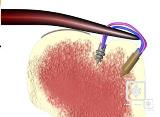Double Row Cuff Repair
A review of the literature
Lennard Funk, August 2007
There has been an increased interest by arthroscopic shoulder surgeons in double row rotator cuff repairs in light of a flurry of publications on the biomechanical effects. Here I have summarised the results of these publications in a comparative table.
Click Here for the summary table
Biomechanical Data:
Laboratory studies show the following advantages of double-row repair:
- Improved footprint repair (Mazocca, 2005; Meier, 2006)
- 60% greater contact (Tuoheti, 2005)
- Increased load to failure (Cummins, 2005)
- Less Gap Formation (Kim, 2006; Smith, 2006)
- Increased Stiffness (Kim, 2006)
- Increased cyclic load to failure (Kim, 2006; Meier, 2006)
In general, It is apparent that increasing the number of anchors and sutures improves repair strength, but only marginally significant. Suture-bridge techniques seem to be better than double-row techniques. However, the clinical effects on improved strength of repair and footprint restoration and are not quite so clear. This is due to wide variation in study designs, models, loading mechanisms, repair techniques, etc.
Clinical Studies:
Three randomised prospective controlled trials in August 2007 provide the best evidence on the outcomes of single versus double row repairs. All report 2 year results using clinical scoring scales and contrast imaging.
The studies used slightly different repair techniques, but the outcomes were similar. Constant and UCLA scores and subjective ratings assessed 2 years after the surgery were largely excellent for both single and double row repairs. Objective healing was evaluated by MRI, CT arthrography and MR arthrography at least 6 months after surgery and showed no significant difference in watertight healing.
Authors Preference:
Steve Crotty & Matt Smith reviewed my arthroscopic rotator cuff repairs from 2005 to 2007. These were all single row repairs and the results were equivalent, if not better, than other published studies on open and arthroscopic rotator cuff repairs. Click here for more detail.
Therefore, I personally reserve double row repair for the following situations:
- Large C-shaped tear (>2cm)
- Poor quality cuff tissue - delaminated or thin
- Poor quality bone - osteoporotic bone
- Revision cuff repair
Summary:
The following factors need to be considered:
- Exactly how strong does the repair need to be to allow for rapid cuff healing.
- There are numerous factors determining the outcome of cuff repair. How big a factor is the number of suture rows?
- Cost-benefit ratio: Double row repairs also double the cost of the procedure
- Increased surgical time with double row repairs.
- The procedure is technically more difficult than single row repairs. Therefore potentially increase the learning curve and complication rates.


